LINCOLN MKS 2015 Owners Manual
Manufacturer: LINCOLN, Model Year: 2015, Model line: MKS, Model: LINCOLN MKS 2015Pages: 424, PDF Size: 3.96 MB
Page 191 of 424
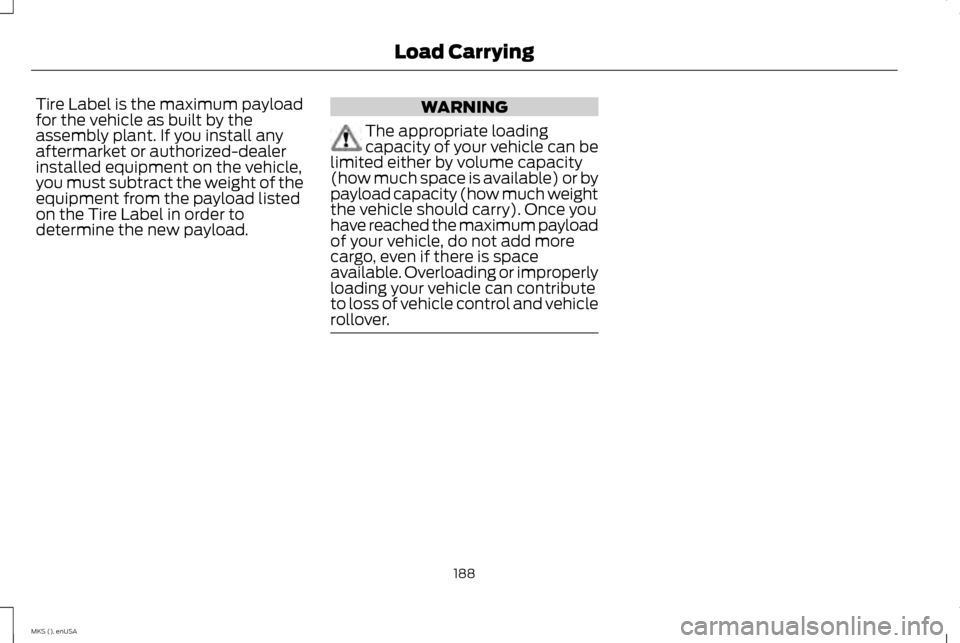
Tire Label is the maximum payload
for the vehicle as built by the
assembly plant. If you install any
aftermarket or authorized-dealer
installed equipment on the vehicle,
you must subtract the weight of the
equipment from the payload listed
on the Tire Label in order to
determine the new payload.
WARNING
The appropriate loading
capacity of your vehicle can be
limited either by volume capacity
(how much space is available) or by
payload capacity (how much weight
the vehicle should carry). Once you
have reached the maximum payload
of your vehicle, do not add more
cargo, even if there is space
available. Overloading or improperly
loading your vehicle can contribute
to loss of vehicle control and vehicle
rollover. 188
MKS (), enUSA Load Carrying
Page 192 of 424
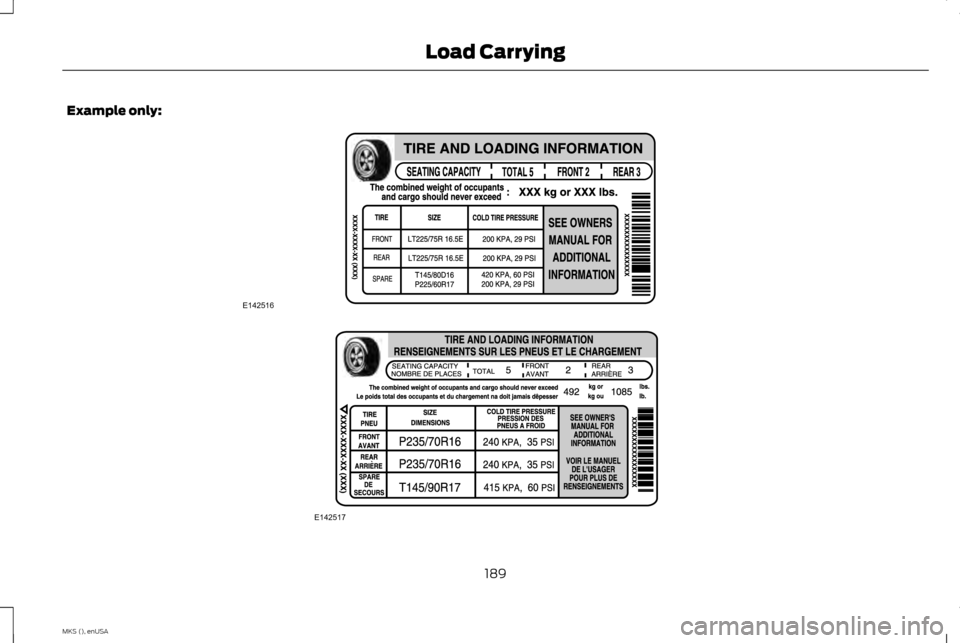
Example only:
189
MKS (), enUSA Load CarryingE142516 E142517
Page 193 of 424
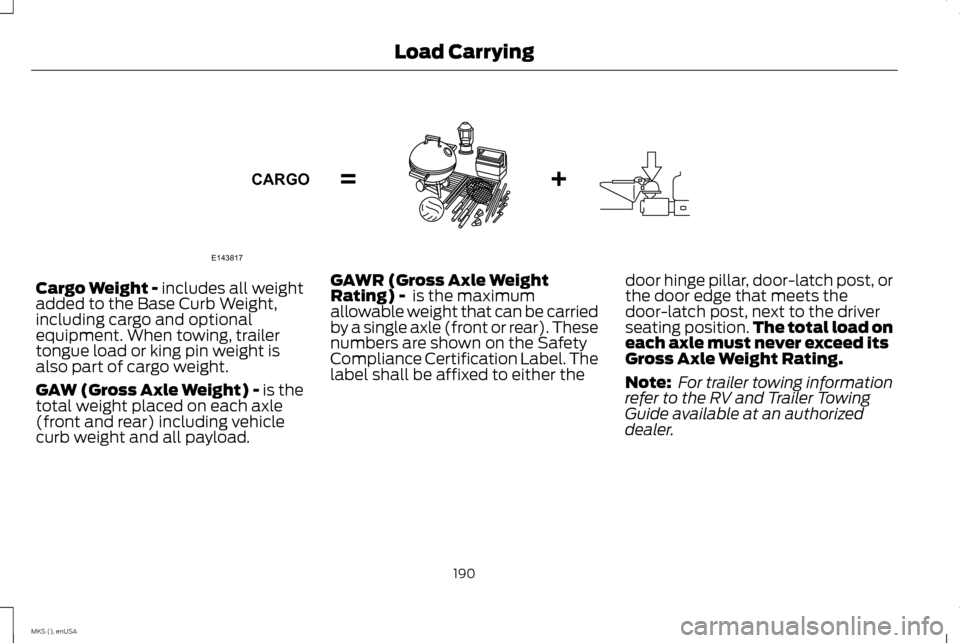
Cargo Weight - includes all weight
added to the Base Curb Weight,
including cargo and optional
equipment. When towing, trailer
tongue load or king pin weight is
also part of cargo weight.
GAW (Gross Axle Weight) - is the
total weight placed on each axle
(front and rear) including vehicle
curb weight and all payload.
GAWR (Gross Axle Weight
Rating) - is the maximum
allowable weight that can be carried
by a single axle (front or rear). These
numbers are shown on the Safety
Compliance Certification Label. The
label shall be affixed to either the door hinge pillar, door-latch post, or
the door edge that meets the
door-latch post, next to the driver
seating position.
The total load on
each axle must never exceed its
Gross Axle Weight Rating.
Note: For trailer towing information
refer to the RV and Trailer Towing
Guide available at an authorized
dealer.
190
MKS (), enUSA Load CarryingE143817CARGO
Page 194 of 424
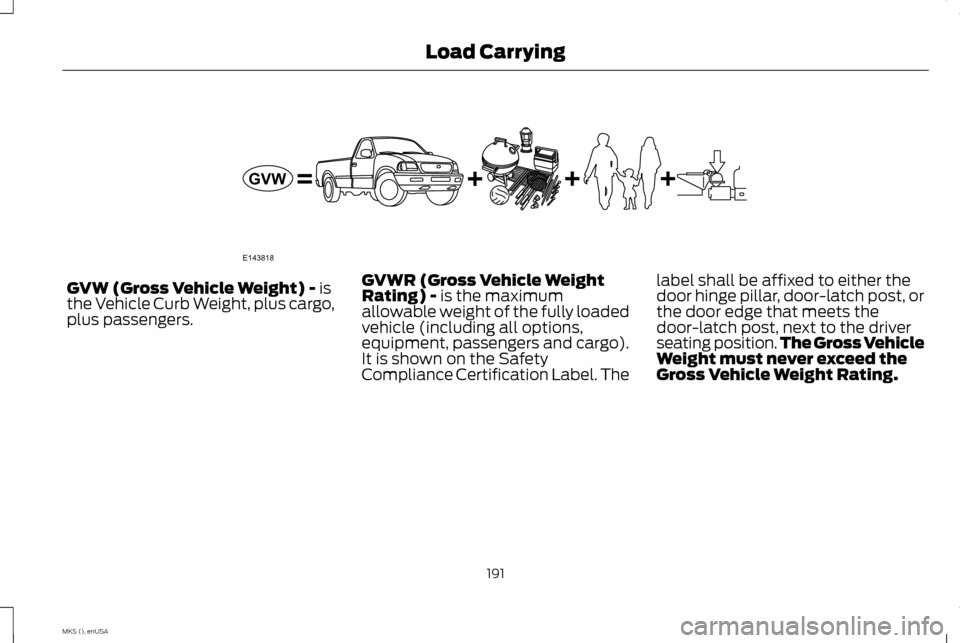
GVW (Gross Vehicle Weight) - is
the Vehicle Curb Weight, plus cargo,
plus passengers. GVWR (Gross Vehicle Weight
Rating) - is the maximum
allowable weight of the fully loaded
vehicle (including all options,
equipment, passengers and cargo).
It is shown on the Safety
Compliance Certification Label. The label shall be affixed to either the
door hinge pillar, door-latch post, or
the door edge that meets the
door-latch post, next to the driver
seating position.
The Gross Vehicle
Weight must never exceed the
Gross Vehicle Weight Rating.
191
MKS (), enUSA Load CarryingE143818GVW
Page 195 of 424
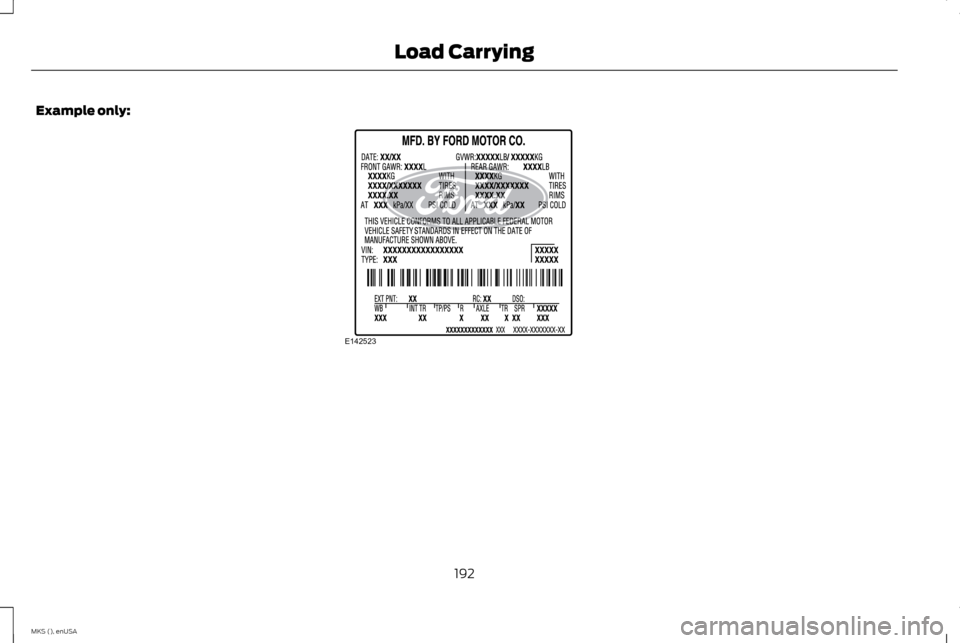
Example only:
192
MKS (), enUSA Load CarryingE142523
Page 196 of 424
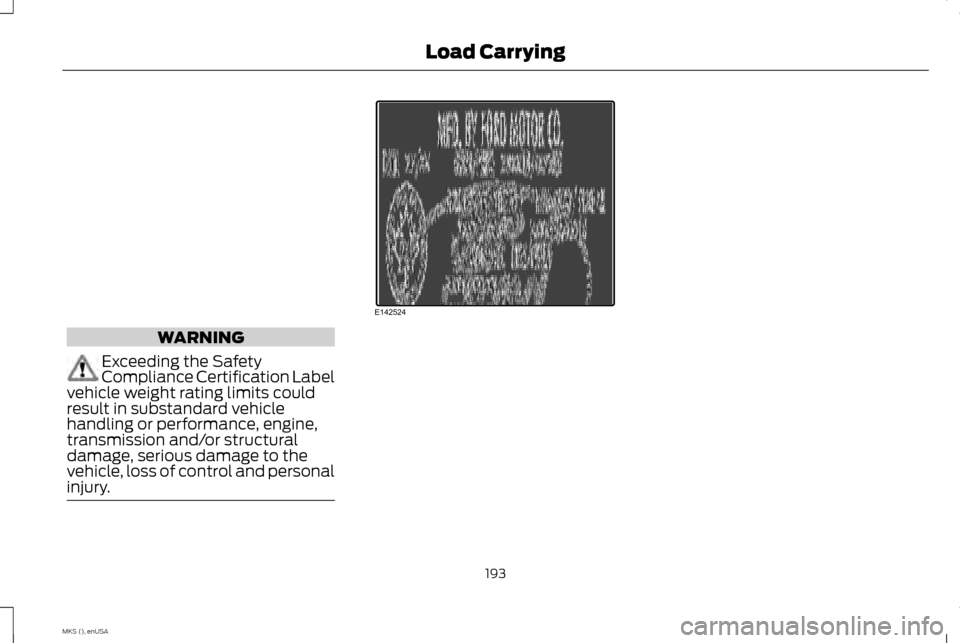
WARNING
Exceeding the Safety
Compliance Certification Label
vehicle weight rating limits could
result in substandard vehicle
handling or performance, engine,
transmission and/or structural
damage, serious damage to the
vehicle, loss of control and personal
injury. 193
MKS (), enUSA Load CarryingE142524
Page 197 of 424
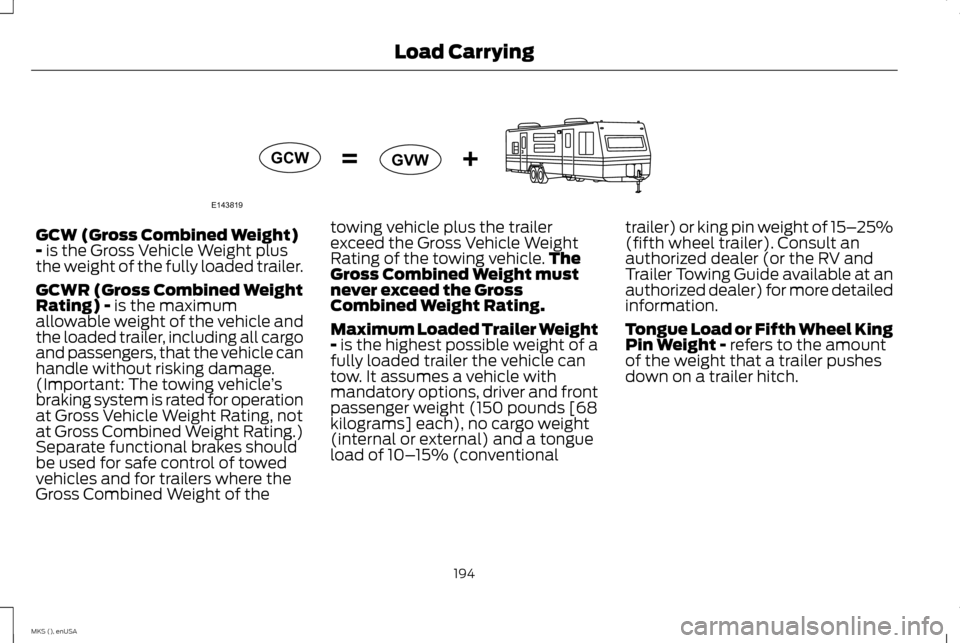
GCW (Gross Combined Weight)
- is the Gross Vehicle Weight plus
the weight of the fully loaded trailer.
GCWR (Gross Combined Weight
Rating) -
is the maximum
allowable weight of the vehicle and
the loaded trailer, including all cargo
and passengers, that the vehicle can
handle without risking damage.
(Important: The towing vehicle ’s
braking system is rated for operation
at Gross Vehicle Weight Rating, not
at Gross Combined Weight Rating.)
Separate functional brakes should
be used for safe control of towed
vehicles and for trailers where the
Gross Combined Weight of the towing vehicle plus the trailer
exceed the Gross Vehicle Weight
Rating of the towing vehicle.
The
Gross Combined Weight must
never exceed the Gross
Combined Weight Rating.
Maximum Loaded Trailer Weight
-
is the highest possible weight of a
fully loaded trailer the vehicle can
tow. It assumes a vehicle with
mandatory options, driver and front
passenger weight (150 pounds [68
kilograms] each), no cargo weight
(internal or external) and a tongue
load of 10– 15% (conventional trailer) or king pin weight of 15–
25%
(fifth wheel trailer). Consult an
authorized dealer (or the RV and
Trailer Towing Guide available at an
authorized dealer) for more detailed
information.
Tongue Load or Fifth Wheel King
Pin Weight - refers to the amount
of the weight that a trailer pushes
down on a trailer hitch.
194
MKS (), enUSA Load CarryingE143819GCW
GVW
Page 198 of 424
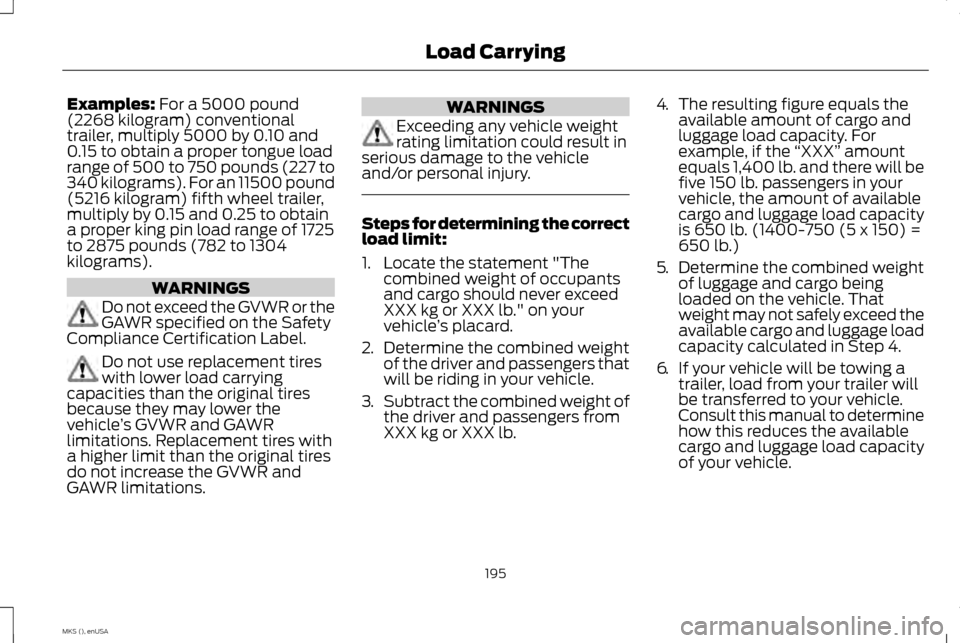
Examples: For a 5000 pound
(2268 kilogram) conventional
trailer, multiply 5000 by 0.10 and
0.15 to obtain a proper tongue load
range of 500 to 750 pounds (227 to
340 kilograms). For an 11500 pound
(5216 kilogram) fifth wheel trailer,
multiply by 0.15 and 0.25 to obtain
a proper king pin load range of 1725
to 2875 pounds (782 to 1304
kilograms). WARNINGS
Do not exceed the GVWR or the
GAWR specified on the Safety
Compliance Certification Label. Do not use replacement tires
with lower load carrying
capacities than the original tires
because they may lower the
vehicle ’s GVWR and GAWR
limitations. Replacement tires with
a higher limit than the original tires
do not increase the GVWR and
GAWR limitations. WARNINGS
Exceeding any vehicle weight
rating limitation could result in
serious damage to the vehicle
and/or personal injury. Steps for determining the correct
load limit:
1. Locate the statement "The
combined weight of occupants
and cargo should never exceed
XXX kg or XXX lb." on your
vehicle ’s placard.
2. Determine the combined weight
of the driver and passengers that
will be riding in your vehicle.
3. Subtract the combined weight of
the driver and passengers from
XXX kg or XXX lb. 4.
The resulting figure equals the
available amount of cargo and
luggage load capacity. For
example, if the “XXX” amount
equals 1,400 lb. and there will be
five 150 lb. passengers in your
vehicle, the amount of available
cargo and luggage load capacity
is 650 lb. (1400-750 (5 x 150) =
650 lb.)
5. Determine the combined weight
of luggage and cargo being
loaded on the vehicle. That
weight may not safely exceed the
available cargo and luggage load
capacity calculated in Step 4.
6. If your vehicle will be towing a
trailer, load from your trailer will
be transferred to your vehicle.
Consult this manual to determine
how this reduces the available
cargo and luggage load capacity
of your vehicle.
195
MKS (), enUSA Load Carrying
Page 199 of 424
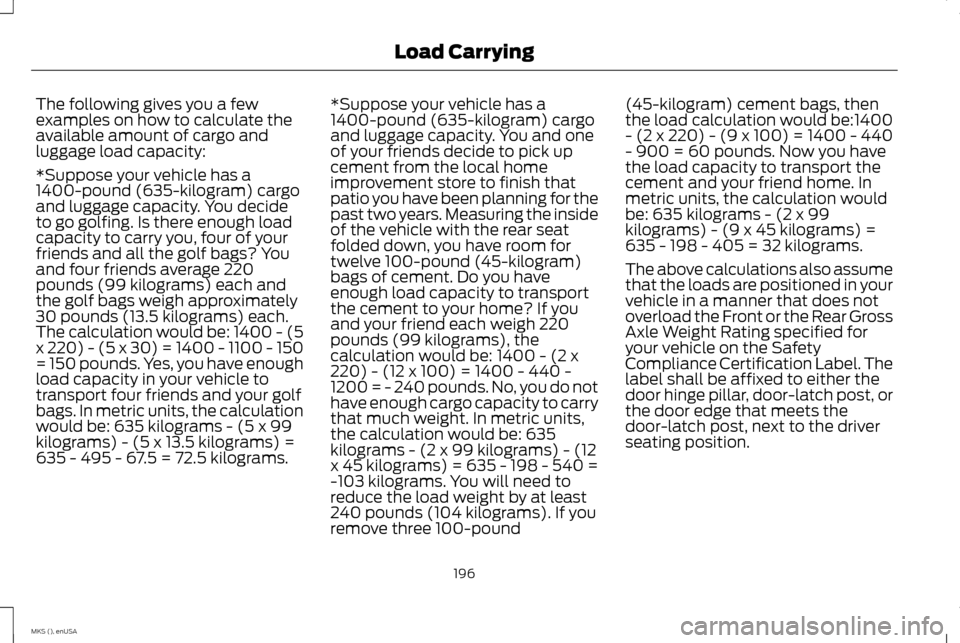
The following gives you a few
examples on how to calculate the
available amount of cargo and
luggage load capacity:
*Suppose your vehicle has a
1400-pound (635-kilogram) cargo
and luggage capacity. You decide
to go golfing. Is there enough load
capacity to carry you, four of your
friends and all the golf bags? You
and four friends average 220
pounds (99 kilograms) each and
the golf bags weigh approximately
30 pounds (13.5 kilograms) each.
The calculation would be: 1400 - (5
x 220) - (5 x 30) = 1400 - 1100 - 150
= 150 pounds. Yes, you have enough
load capacity in your vehicle to
transport four friends and your golf
bags. In metric units, the calculation
would be: 635 kilograms - (5 x 99
kilograms) - (5 x 13.5 kilograms) =
635 - 495 - 67.5 = 72.5 kilograms.
*Suppose your vehicle has a
1400-pound (635-kilogram) cargo
and luggage capacity. You and one
of your friends decide to pick up
cement from the local home
improvement store to finish that
patio you have been planning for the
past two years. Measuring the inside
of the vehicle with the rear seat
folded down, you have room for
twelve 100-pound (45-kilogram)
bags of cement. Do you have
enough load capacity to transport
the cement to your home? If you
and your friend each weigh 220
pounds (99 kilograms), the
calculation would be: 1400 - (2 x
220) - (12 x 100) = 1400 - 440 -
1200 = - 240 pounds. No, you do not
have enough cargo capacity to carry
that much weight. In metric units,
the calculation would be: 635
kilograms - (2 x 99 kilograms) - (12
x 45 kilograms) = 635 - 198 - 540 =
-103 kilograms. You will need to
reduce the load weight by at least
240 pounds (104 kilograms). If you
remove three 100-pound(45-kilogram) cement bags, then
the load calculation would be:1400
- (2 x 220) - (9 x 100) = 1400 - 440
- 900 = 60 pounds. Now you have
the load capacity to transport the
cement and your friend home. In
metric units, the calculation would
be: 635 kilograms - (2 x 99
kilograms) - (9 x 45 kilograms) =
635 - 198 - 405 = 32 kilograms.
The above calculations also assume
that the loads are positioned in your
vehicle in a manner that does not
overload the Front or the Rear Gross
Axle Weight Rating specified for
your vehicle on the Safety
Compliance Certification Label. The
label shall be affixed to either the
door hinge pillar, door-latch post, or
the door edge that meets the
door-latch post, next to the driver
seating position.
196
MKS (), enUSA Load Carrying
Page 200 of 424
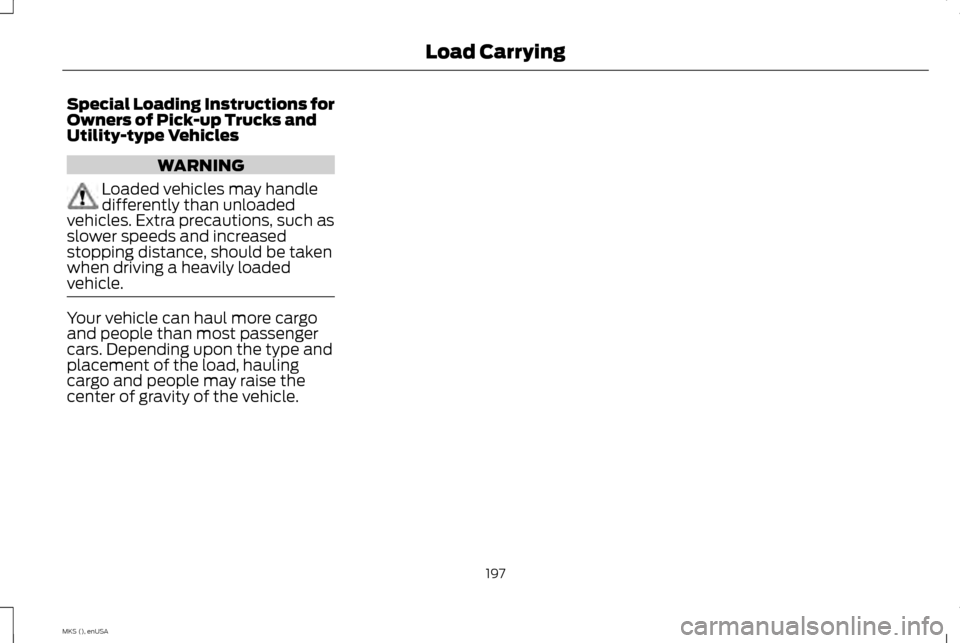
Special Loading Instructions for
Owners of Pick-up Trucks and
Utility-type Vehicles
WARNING
Loaded vehicles may handle
differently than unloaded
vehicles. Extra precautions, such as
slower speeds and increased
stopping distance, should be taken
when driving a heavily loaded
vehicle. Your vehicle can haul more cargo
and people than most passenger
cars. Depending upon the type and
placement of the load, hauling
cargo and people may raise the
center of gravity of the vehicle.
197
MKS (), enUSA Load Carrying